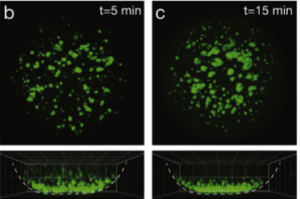
Nucleoli settle and clump as one big droplet at the bottom of the frog oocyte nucleus without the presence of nuclear actin. Courtesy of C. Brangewynne. Photo. Nature.
Gravity may limit cell growth and size limit. Professor Cliff Brangwynne of the Chemical and Biological Engineering Department of Princeton University presented his research on Nuclear Actin, RNA Droplets and Gravity on Tuesday, September 24, explaining the research that led to his recent conclusion.
Typical eukaryotic cells are about 10µm in diameter, but some cells become very large in size – especially oocytes or immature eggs. Professor Brangwynne studied the effects of gravity on the oocytes of the frog X. laevis, which not only grow to diameters of around 1mm, but also have nuclei as large as 450µm in diameter.
Brangwynne discovered that larger nuclei have higher concentrations of a globular protein called actin. Actin, while typically known as a protein involved in the cytoplasm, is also in the nucleus. In the nucleus, it is involved in various processes such as transcription, transcription regulation, RNA processing, intranuclear movement, and structure maintenance.

Nucleoli settle and clump as one big droplet at the bottom of the frog oocyte nucleus without the presence of nuclear actin. Courtesy of C. Brangewynne, from Feric, Marina and Brangwynne. Photo. Nature.
Nucleoli, ribonucleoproteins, make up about 25% of a large egg nucleus’s volume and play a part in ribosome formation. Nucleoli behave as liquid droplets, but despite the predicted gravitational force exerted on these droplets, they do not pool at the bottom of the nucleus as one big droplet.
To test why, Professor Brangwynne used microrheology. In microrheology, the researchers insert tiny tracers inside a medium and observe the tracers’ flows to determine the medium’s viscosity and the presence of obstacles. Larger tracers in Brangwynne’s research showed very little movement, indicating the presence of a mesh like network.
Believing the mesh like network to be a nuclear actin network, Professor Brangwynne injected XPO6 or exportin-6, a nuclear protein that exports actin from the nucleus, to remove actin from the nucleus. After the removal of actin from the large nucleus, Brangwynne observed the pooling of nucleoli as he had predicted; gravity, in fact, does have an impact on cells.
Brangwynne also noticed that the nucleoli was not the only structure to settle down. Tiny structures known as histone-locus bodies or HLBs also pool at the bottom, but due to their smaller size and mass, they take a longer time to settle. Actin networks thus prevent the sedimentation of intranuclear structures of large cells in the presence of gravity. The energy expenditure necessary to maintain these actin networks supports the notion of gravity as a limiter on cell growth and size.
To quantify these effects, Professor Brangwynne calculated the gravitational length scale for various cellular structures to determine the respective heights after which the gravitational forces on these structures becomes non-negligible. This led to the prediction that chromosomes may also sediment at the bottom of large cells without the aid of actin networks.
He is now working on reinserting the actin network after its removal and the effect of the reinsertion on large nuclei.
Leave a Reply